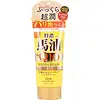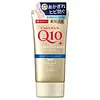What's inside
What's inside
 Key Ingredients
Key Ingredients

 Benefits
Benefits

 Concerns
Concerns

 Ingredients Side-by-side
Ingredients Side-by-side

Water
Skin ConditioningGlycerin
HumectantStearic Acid
CleansingCetyl Alcohol
EmollientEthylhexyl Palmitate
EmollientParaffinum Liquidum
EmollientPropanediol
SolventHorse Fat
Skin ConditioningNiacinamide
SmoothingUbiquinone
AntioxidantPersea Gratissima Oil
Skin ConditioningArgania Spinosa Kernel Oil
EmollientSqualane
EmollientHoney
HumectantSimmondsia Chinensis Seed Oil
EmollientLactobacillus/Soymilk Ferment Filtrate
Skin ConditioningPlacental Extract
Sh-Barley Seed Extract
Skin ConditioningHydrogenated Lecithin
EmulsifyingBehenyl Alcohol
EmollientPolysorbate 60
EmulsifyingSorbitan Stearate
EmulsifyingPhenoxyethanol
PreservativeMethylparaben
PreservativePotassium Hydroxide
BufferingTrisodium EDTA
Propylparaben
PreservativeButylene Glycol
Humectant1,2-Hexanediol
Skin ConditioningDimethicone
EmollientUrea
BufferingParfum
MaskingWater, Glycerin, Stearic Acid, Cetyl Alcohol, Ethylhexyl Palmitate, Paraffinum Liquidum, Propanediol, Horse Fat, Niacinamide, Ubiquinone, Persea Gratissima Oil, Argania Spinosa Kernel Oil, Squalane, Honey, Simmondsia Chinensis Seed Oil, Lactobacillus/Soymilk Ferment Filtrate, Placental Extract, Sh-Barley Seed Extract, Hydrogenated Lecithin, Behenyl Alcohol, Polysorbate 60, Sorbitan Stearate, Phenoxyethanol, Methylparaben, Potassium Hydroxide, Trisodium EDTA, Propylparaben, Butylene Glycol, 1,2-Hexanediol, Dimethicone, Urea, Parfum
Dipotassium Glycyrrhizate
HumectantTocopheryl Acetate
AntioxidantWater
Skin ConditioningGlycerin
HumectantPEG-8 Dimethicone
EmulsifyingAlcohol Denat.
AntimicrobialPetrolatum
EmollientDiisostearyl Malate
EmollientPEG-9 Polydimethylsiloxyethyl Dimethicone
EmulsifyingTocopherol
AntioxidantPrunus Amygdalus Dulcis Oil
Skin ConditioningOlea Europaea Fruit Oil
MaskingSodium Hyaluronate
HumectantSimmondsia Chinensis Seed Oil
EmollientUbiquinone
AntioxidantCollagen Powder
HumectantDisodium EDTA
Di-T-Butylhydroquinone
AntioxidantDisodium Phosphate
BufferingSodium Chloride
MaskingMethyl/Phenyl Polysilsesquioxane
Phenoxyethanol
PreservativeMethylparaben
PreservativeDipotassium Glycyrrhizate, Tocopheryl Acetate, Water, Glycerin, PEG-8 Dimethicone, Alcohol Denat., Petrolatum, Diisostearyl Malate, PEG-9 Polydimethylsiloxyethyl Dimethicone, Tocopherol, Prunus Amygdalus Dulcis Oil, Olea Europaea Fruit Oil, Sodium Hyaluronate, Simmondsia Chinensis Seed Oil, Ubiquinone, Collagen Powder, Disodium EDTA, Di-T-Butylhydroquinone, Disodium Phosphate, Sodium Chloride, Methyl/Phenyl Polysilsesquioxane, Phenoxyethanol, Methylparaben
Ingredients Explained
These ingredients are found in both products.
Ingredients higher up in an ingredient list are typically present in a larger amount.
Glycerin is already naturally found in your skin. It helps moisturize and protect your skin.
A study from 2016 found glycerin to be more effective as a humectant than AHAs and hyaluronic acid.
As a humectant, it helps the skin stay hydrated by pulling moisture to your skin. The low molecular weight of glycerin allows it to pull moisture into the deeper layers of your skin.
Hydrated skin improves your skin barrier; Your skin barrier helps protect against irritants and bacteria.
Glycerin has also been found to have antimicrobial and antiviral properties. Due to these properties, glycerin is often used in wound and burn treatments.
In cosmetics, glycerin is usually derived from plants such as soybean or palm. However, it can also be sourced from animals, such as tallow or animal fat.
This ingredient is organic, colorless, odorless, and non-toxic.
Glycerin is the name for this ingredient in American English. British English uses Glycerol/Glycerine.
Learn more about GlycerinMethylparaben is a preservative and is a paraben. It is used to prevent the growth of fungus, mold, and other harmful bacteria. Parabens are chemicals used as preservatives in both cosmetics and food.
Methylparaben can be synthetically created. It can also be found naturally in some fruits, such as blueberries.
Oftentimes, Methylparaben is combined with other parabens to help increase the shelf life.
The safety of Methylparaben is currently being studied. While ongoing studies are looking into the safety of parabens, the results have been very mixed. Some studies have not found Methylparaben to be harmful.
Learn more about MethylparabenPhenoxyethanol is a preservative that has germicide, antimicrobial, and aromatic properties. Studies show that phenoxyethanol can prevent microbial growth. By itself, it has a scent that is similar to that of a rose.
It's often used in formulations along with Caprylyl Glycol to preserve the shelf life of products.
This oil comes from the seeds of the desert shrub called Jojoba. It is more commonly known as jojoba oil, a non-comedogenic oil.
Jojoba oil does not contain fragrance and has many fatty-acids, making it a great soothing ingredient.
It also contains Vitamin E, a great moisturizing ingredient. Vitamin E is also an antioxidant and protects your skin against oxidative damage.
This ingredient humectant properties, meaning it helps draw moisture from the air. This helps keep your skin hydrated.
While jojoba has antibacterial properties, it is only able to kill some strains of bacteria.
Studies also show it helps in wound healing. In fact, Indigenous cultures have used jojoba as a moisturizer and to help treat burns for centuries.
Fun fact: Jojoba oil similar to natural human skin sebum, so it has a great effect on dry skin. It is also promising with helping to regulate sebum production.
Due to its fatty acid content, Jojoba oil may not be fungal acne safe. We recommend speaking with a professional if you have any concerns.
Learn more about Simmondsia Chinensis Seed OilUbiquinone (Coenzyme Q10) is a molecule already found in our bodies. It is a potent antioxidant and skin-soothing ingredient.
Aging and environmental exposure diminishes our skin's natural ubiquinone levels. This is much like our natural collagen and elastin.
The good news is: studies show applying this ingredient topically replenishes ubiquinone levels in our skin. This also comes with a ton of skin benefits. These benefits include:
Ubiquinone is considered a large molecule and cannot be absorbed into the lower layers of skin. This is why it is believed to be such an effective antioxidant: it protects our skin in the upper layers and prevents damage in the deeper layers.
When used in sunscreen, ubiquinone is shown to increase ingredient stability, increase SPF factor, and add to infrared protection.
Fun fact: ubiquinone is fat-soluble.
Learn more about UbiquinoneWater. It's the most common cosmetic ingredient of all. You'll usually see it at the top of ingredient lists, meaning that it makes up the largest part of the product.
So why is it so popular? Water most often acts as a solvent - this means that it helps dissolve other ingredients into the formulation.
You'll also recognize water as that liquid we all need to stay alive. If you see this, drink a glass of water. Stay hydrated!
Learn more about Water